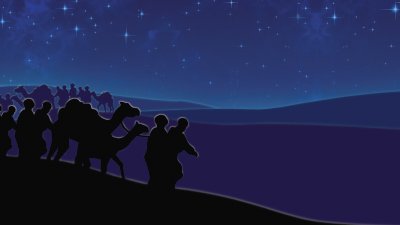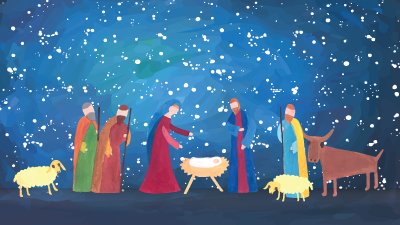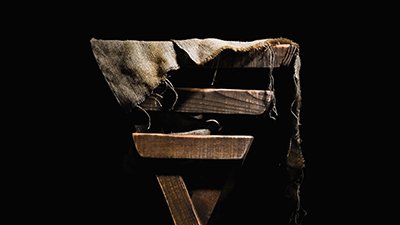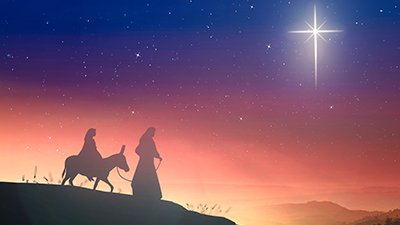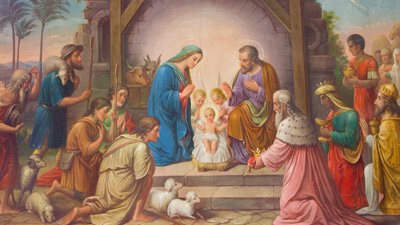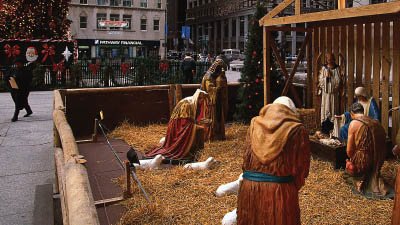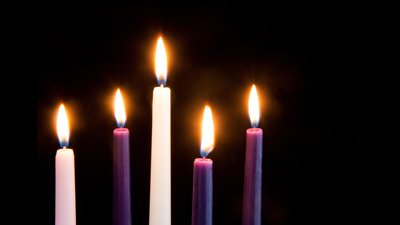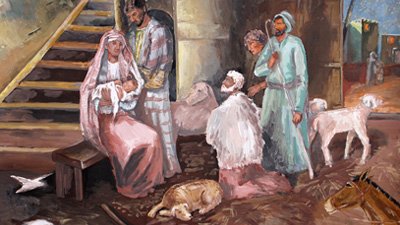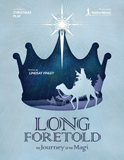Christmas
Christmas is an annual holiday on December 25 commemorating the birth of Jesus Christ. The original term for Christmas meant “Christ’s Mass,” related to the celebration of the Eucharist of the Christ. The holiday was introduced in AD 379 in Constantinople. Though Christmas is a uniquely Christian holiday, it is often celebrated by both Christians and non-Christians in different ways.
Christians who celebrate Christmas remember the incarnation. That’s when Jesus, the Son of God, entered into human history, became a man, lived a perfect life, was unjustly crucified on a Roman cross, and was raised from the dead (Acts 10:39–40; 1 Corinthians 15:3–4). Christians commemorate actual historical events in Christmas activities and celebrations. Though many in 21st-century Western countries reject Christian references and import secular ideas into the holiday celebrations, Christmas is still a much-beloved holiday throughout the world.
Contents
The Story of Christmas
Christmas commemorates the birth of a baby—an event recorded in the New Testament and prophesied about in Old Testament passages such as Isaiah 7:14. The name given to this baby was Jesus. The Gospel of Luke records the birth of Jesus.
And in the same region there were shepherds out in the field, keeping watch over their flock by night. And an angel of the Lord appeared to them, and the glory of the Lord shone around them, and they were filled with great fear. And the angel said to them, “Fear not, for behold, I bring you good news of great joy that will be for all the people. For unto you is born this day in the city of David a Savior, who is Christ the Lord. And this will be a sign for you: you will find a baby wrapped in swaddling cloths and lying in a manger.” And suddenly there was with the angel a multitude of the heavenly host praising God and saying, “Glory to God in the highest, and on earth peace among those with whom he is pleased!”
When the angels went away from them into heaven, the shepherds said to one another, “Let us go over to Bethlehem and see this thing that has happened, which the Lord has made known to us.” And they went with haste and found Mary and Joseph, and the baby lying in a manger. And when they saw it, they made known the saying that had been told them concerning this child. And all who heard it wondered at what the shepherds told them. But Mary treasured up all these things, pondering them in her heart. And the shepherds returned, glorifying and praising God for all they had heard and seen, as it had been told them. (Luke 2:8–20)
Christmas Traditions
During Christmastime, many churches display nativity scenes. These exhibits show the newborn Jesus in a stable surrounded by various animals, shepherds, and Mary and Joseph. Such nativity scenes traditionally have also been displayed in public places (shopping centers, public schools, parks, etc.) in much of our Western world.
In addition to the overt Christian traditions, many have adopted non-religious traditions to celebrate Christmas. These traditions include decorating houses and buildings with lights, giving presents to each other, and a day dedicated to Christmas shopping at the end of November, Black Friday—among other traditions. Non-religious celebrations also incorporate an entire mythology about Santa Claus, his workshop elves, and gift-giving to children. Though many of these traditions have Christian roots, the Christmas holiday in Western countries is often devoid of Christian meaning.

Four Misconceptions About Christmas
- The X Stands for Christ: Though the first Greek letter of this title (the letter chi) looks like an x in English, some have used it as an abbreviation for Christ, but there is no question that many use the X today for the very purpose of eliminating Christ.
- Jeremiah 10 Forbids the Use of Christmas Trees: If a Christmas tree is ever elevated to the point where it becomes an idol or a stumbling block to worshiping the Lord, then it would be wrong. However, many people choose to use an evergreen tree in other ways.
- Jesus Was Born on December 25: This is another issue that can sometimes turn into a heated discussion, but such argument is unnecessary. The fact is that we really do not know.
- We Should Not Celebrate Christmas: While we are not commanded to celebrate the birth of Christ, we do see precedent in Scripture.
Genealogy of Jesus
Jesus is the Savior who was promised throughout history. The genealogy of Jesus in Matthew and in Luke show him as the descendant of Abraham, Isaac, Jacob, and eventually David—men to whom these prophecies were made. God promised Abraham that all nations would be blessed through his offspring, which was ultimately fulfilled in Jesus Christ (Galatians 3:7–9, 16).
By reading these genealogies, we also see that Jesus was a direct descendent of King David. Jesus’ genealogy is also a fulfillment of many Old Testament promises. The promised Messiah would be the descendant of David (2 Samuel 7:12–14) and would one day rule on David’s throne (Isaiah 9:6–7).

The Creator in the Manger
At Christmastime, we celebrate the day that the eternal Creator entered his creation. The Creator who stretched out the heavens was laid beneath them in a manger. The limitless Son of God took on human limitations, being born in the flesh. As a baby, Jesus depended on Joseph and Mary for care and nourishment. Yet the humility of his incarnation did not detract from the glory of his deity: “And the Word became flesh and dwelt among us, and we have seen his glory, glory as of the only Son from the Father, full of grace and truth.” (John 1:14).
Virgin Birth of Jesus
The virgin birth of Jesus is a miracle. God the Holy Spirit worked supernaturally in a human womb, and a child was conceived apart from a human father—a child who was truly and fully both man and God. With a human mother and God as his father, Jesus was the only God-man ever to exist.

The Christmas Star
The star mentioned in Matthew is not necessarily what we normally think of as a star. That is, it was not necessarily an enormous mass of hydrogen and helium gas powered by nuclear fusion. The Greek word translated star is aster (αστηρ), which is where we get the word astronomy. In the biblical conception of the word, a star is any luminous point of light in our night sky. This would certainly include our modern definition of a star, but it would also include the planets, supernovae, comets, or anything else that resembles a point of light.
Visit of the Magi
Many scholars believe the Prophet Daniel’s influence in the Babylonian and Persian empires led to the magi’s familiarity with the Jewish scriptures. Whether or not this is the case, the magi were being drawn by the God of the Jews to visit his Son in Israel.

What About Santa Claus?
Sadly, our culture has shifted its focus to dazzling decorations and away from a dazzling Savior. Commercialism has swallowed whatever Christmas used to be. Battles are fought over the very name of the holiday, and Santa Claus is embraced more freely than the infant Jesus. Santa is an icon in modern culture, and his image is used to sell everything from soda to sports cars. We can learn from God’s Word How should Christians view Santa Claus—in light of the true meaning of Christmas?
Is Christmas a Pagan Holiday?
The Church has often failed during the Christmas season because we rarely talk about the birth of Christ while explaining why he came. Whether Christmas happens to occur at the same time (or close to the same time) as a pagan holiday is irrelevant. There is nothing inherently wrong with celebrating a Christian holiday at the same time pagans celebrate (Colossians 2:16), especially if it gives us opportunities to present the gospel.
What should be of greater concern to Christians is the extent to which we have adopted some of the pagan practices during Christmastime. Some have gone overboard on this, and we should be cautious of making Christmas more about mythical beings like Santa, Rudolph, and so on than about the historical birth of Christ and, most importantly, why he came.

“War” on Christmas
Today, conflicts surrounding Christmas include whether it’s ok to say “Merry Christmas” or display nativity scenes in public places. There are even claims that Christmas was originally a pagan idea!
As the influence of secularists has grown, there has been an attack on Christmas. Even if Christians choose not to celebrate it, they should be at least equipped to defend the historicity of the account of Jesus coming to earth as recounted in the Bible and ready to tell others why he came and what that means for humanity.
Conclusion: The Real Meaning of Christmas
The true gift of Christmas is Christ—the Son of God, who chose to become one of us to effectively sacrifice himself for the atonement of our sins and to save us from a just, eternal punishment for Adam’s and our rejection of our Creator. We are blessed exceedingly by Jesus’ gift. Do we truly understand who Jesus is and what he did? Forget about all the secular Christmas hype, focus on what you are giving to Christ, what he gave to you, and worship him. The real reason for Christmas is the gift we have received from God, so we gratefully give back to him the worship he deserves and a life centered on him.
News About Christmas
Articles About Christmas
-
Dec. 21, 2025 from Answers Magazine
In the book of Matthew, it is recorded that the birth of Jesus was accompanied by an extraordinary celestial event: a star led the magi (the “wise men”) to Jesus.
-
-
Oct. 1, 2021 from Answers Magazine
These devotionals provide one lesson per week for family or private devotions in the months leading up to Christmas.
-
Dec. 24, 2016 from The New Answers Book 2
What was the star? And how did it lead the magi to the Lord? There have been many speculations.
-
Dec. 20, 2016 from Misconceptions Series
Tim Chaffey and Jeremy Ham (AiG–US) examine four misconceptions about Christmas.
-
Dec. 19, 2016 from Answers Magazine
The Bible is no longer widely accepted as the final authority in American culture, and the Christmas season generates a multitude of questions from people.
-
Celebrating Christ’s BirthDec. 25, 2015
What is the appropriate response to the greatest gift ever given?
-
Dec. 22, 2015 from Misconceptions Series
The idea of an angelic chorus singing praises to God has become very common, but does the Bible state that the angels sang on the night of Christ’s birth?
-
Dec. 12, 2015 from Misconceptions Series
Was Jesus born among the animals in the stable because there was no room for Joseph and Mary at the inn?
-
Dec. 16, 2014 from Misconceptions Series
Nativity displays often have three wise men. What does the Bible reveal about these wise men? Who were they? Where were they from?
-
Feedback ArticleChristians Celebrating Christmas at Christmas TownDec. 21, 2012 from Feedback
Some Christians have been convinced that believers should have nothing to do with Christmas for various reasons. Tim Chaffey, AiG–U.S., responds to these concerns.
-
What They Know Is a MythJan. 10, 2011
Atheists recently launched a billboard campaign calling a fanciful image of Christmas a myth. Perhaps they should use their reason to study what the Bible actually teaches.
-
Feedback ArticleA Manger Misconception?Jan. 7, 2011 from Misconceptions Series
Does a manger refer to a whole stall or just a feeding trough? Tim Chaffey, AiG–U.S., explains.
-
Feedback ArticleWould Joseph’s Family Shun Mary?Dec. 31, 2010 from Misconceptions Series
Would Joseph’s relatives still have accepted him, or more importantly Mary, into their homes, because they would have thought that Mary was pregnant out of wedlock?
-
Semi-Technical In-Depth ArticleAn Evaluation of The Star of Bethlehem DVDDec. 22, 2010 from Answers in Depth
In this DVD, Larson presents his journey to determine what the star of Bethlehem was.
-
-
Clearing Up Misconceptions: IntroductionNov. 29, 2010 from Misconceptions Series
One of the keys to taking a stand on the Word of God is making sure we understand what is actually stated in the Bible. Tim Chaffey, AiG–U.S., introduces the Clearing Up Misconceptions web series.
-
The Hands that Created the World—Made the Hands that Were Now Holding HimDec. 25, 2009
On this Christmas Day, Ken Ham asks that you consider the magnitude of Christ’s sacrifice.
-
What Does Christmas Have to Do with Creation?Dec. 21, 2009
You may think the Creation Museum is about scientific evidences and Genesis, and Christmas is about the “warm and fuzzy” stuff of Christianity—specifically the birth of Christ. You might be surprised.
-
The “Defense of Christmas”Dec. 24, 2001
Skeptics often bring up these challenges to Scriptural authority during the Christmas season. Know how to answer them?
Recommended Resources

Answers in Genesis is an apologetics ministry, dedicated to helping Christians defend their faith and proclaim the good news of Jesus Christ.
- Customer Service 800.778.3390
- Available Monday–Friday | 9 AM–5 PM ET
- © 2025 Answers in Genesis



